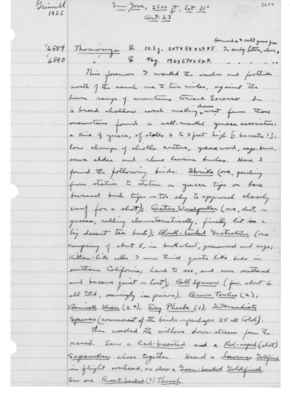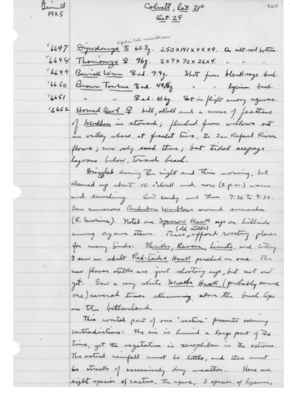Pages That Mention Thomomys
1925: Joseph Grinnell's field notes
S3 Page 37
Collector: Grinnell - 1925 Location: La Grulla, 7200 ft. Date: Oct. 9 Page Number: 2580
doubtless hardly covered with dirt as they go. I suppose they find the insects in the leaf-mold under the thickets here and there. Lamb and I both have "modified" Macabee gofer (sic) traps set all the time for the moles, but this species is so small that an individual goes thru and thru (sic) a trap without springing it, or if sprung, without nipping(?) him. 7:00 p.m. -- Barometer = 23.20 inches Sky partly overcast, but northwest wind blowing cold. 6466 Merriam Chipmunk (male sign) 56g. 226x98x34x14. Under boulder. 6467 Merriam Chipmunk (male sign) 55.4g. 217x90x33x16. Under manzanita. Oct. 10 6468 Thomomys (female sign) 88g. 196x71x29.5x4. In wet sand. 6469 Thomomys (male sign) 129 g. 225x80x32x4 In dry "second(?)bottom". Discarded: 1 Peromyscus maniculatus (male sign), under edge of boulder by cascara thicket; P. truei, 1 (male sign), 1 (female sign);by cascara bushes and boulders; P. boylii (male sign), by manzanita, on dry upland. 6470 Audubon Warbler (female sign) im. 10.0g. Shot in willow by stream. 6471 Pigmy Nuthatch (male sign)ad. 10.5g. Shot on ground under pine. 6472 Slender-billed Nuthatch (male sign) ad. 16.4g. Shot from high in pine. 6473 Townsend Junco (male sign) ad. 18.6g. Shot on top of boulder. 6474 White-crowned Sparrow (male sign) ad. 26.9g. Shot in willow by stream. 6475 Monterey Hermit Thrush (male sign) im. 21.8(?)g. Shot in cascara bush. 6476 Tanager (male sign) im. 25.3g. Shot in cascara bush under pine. 6477 Bluebird (male sign) ad. 27.0g. Shot from lower branch of pine. 6578 Spurred Towhee (female sign) ad. 36.4g. Shot in top of cascara bush. 6479 "Pinero" (female sign) ad. 91.4g. Shot from pine.
S3 Page 59
S3 Page 59
Collector: Grinnell - 1925 Location: San Jose, 2500 ft., lat. 31° Date: Oct. 23 Page Number: 2602
6589 Thomomys (female sign) 123g. 207 x 58 x 29 x 5. In sandy bottom, where bermuda & salt grass grow. 6590 “ (female sign) 96g. 190 x 57 x 25 x 4. “ “ “ “ “ “
This forenoon I worked the washes and foothills north of the ranch one to two miles, against the lower range of mountains toward Socorro. In a broad shallow wash down west from those mountains found a well-marked yucca association: a kind of yucca, of stalks 6 to 8 feet high [= buccata?]; low clumps of cholla cactus, greasewood, sage-brush, some alder and rhus laurina bushes. Here I found the following birds: Shrike (one, perching from station to station in yucca tips on bare burned bush tips - too shy to approach closely enuf for a shot); Cactus Woodpecker(one, shot, on yuccas, calling characteristically, finally lit in a big desert tea bush); Black-tailed Gnatcatcher (one company of about 5, in buckwheat, greasewood and sage; kitten-like calls I now think quite like birds in Southern California; hard to see, and soon scattered and became quiet - lost); Ball Sparrow (few, about 6 all told, seemingly in pairs); Brown Towhee (2); Bewick Wren (2+); Say Phoebe (1); Intermediate Sparrow (commonest of the birds - perhaps all 25 told).
Then worked the willows down-stream from the ranch. Saw a Red-breasted and a Red-naped (shot) Sapsucker close together. Heard a Lawrence Goldfinch in flight overhead, as also a Green-backed Goldfinch. Saw one Russet-backed (?) Thrush.
S3 Page 68
Collector: Grinnell - 1925 Location: Colnett, Sat. 31 degrees Date: October 29, 1925 Page Number: 2610
6647 Dipodomys (male sign) 60.3g. 250 x 141 x 42 x 9. On silt-soil bottom. 6648 Thomomys (female sign) 96g. 207 x 70 x 26 x 4. “ “ “ 6649 Bewick Wren (female sign) ad. 9.9g. Shot from black-sage bush. 6650 Brown Towhee (male sign) ad. 44.5g “ “ lycium bush. 6651 “ “ (female sign) ad. 41.6g. Shot in flight among agaves. 6652 Horned Owl (female sign) bill, skull and a mass of feathers of Mudhen in stomach; flushed from willows out in valley where, at freshet time, the San Rafael River flows; now only sand there; but tidal seepage lagoons below, toward beach.
Drizzled during the night and this morning, but cleared up about 10 o’clock and now (2 p.m.) warm and sunshiny. Out early and then 7:30 to 9:30. Saw numerous Audubon Warblers around sumachs (R. laurina). Noted one Sparrow Hawk up on hillside among agave stems. These (old stalks) afford roosting places for many birds: Shrikes Ravens, Linnets, and today I saw an adult Red-Tailed Hawk perched on one. The new flower stalks are just shooting up, but not out yet. Saw a very white Marsh Hawk (probably same one) several times skimming above the bush tops on the bottomland. The coastal part of our “section” presents seeming contradictions: the air is humid a large part of the time, yet the vegetation is xerophilous in the extreme. The actual rainfall must be little, and there must be streaks of excessively dry weather. Here are eight species of cactus, the agave, 3 species of lycium,


